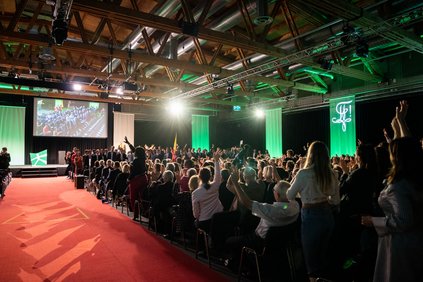Campus - 30.07.2018 - 00:00
Revitalizing Förderer's architecture
Cleaning, polishing, oiling. Drilling, screwing and hammering, too. The Building Services and “Construction and Technology” teams are carrying out intensive work on the University of St.Gallen campus. They will not only be performing maintenance, but also creating some new features.

31 July 2018. Right now windows are being cleaned, floors polished and walls painted. The wooden parquet flooring in the Library Building needs its annual maintenance, too. Our Facility Management Department uses the inter-term break to give the buildings on the University of St.Gallen campus some 'life-support' measures. "Everything that you would do in your own house or apartment, we do in concentrated form during the holiday period," says Hans Jörg Baumann, Head of the Facility Management Department. "Our noise-intensive work is carried out during the times when there are fewest people on the site".
This summer there have also been some visual changes on campus. Students, staff and guests will find new outdoor furniture on the forecourt of the University Restaurant, on the terrace at Varnbüelstrasse 16, and in the intermediate area of the main block and the Library Building. With trees and parasols offering shade, these new areas will provide an inviting place to work, study, or converse in the fresh air. Indeed, the university has invested not only in better interactions on campus, but in security and technology as well. "During the summer, we restored and modernized the entire evacuation and fire alarm system as well as the technical infrastructure in the group rooms, the Audimax and the Senate Room".
Redesigned seminar rooms
In October 2018, students will no longer recognize the seminar rooms on the first floor of the Library Building. New teaching and learning spaces are currently being created here, based on an innovative didactic concept. "The spaces are intended to support collaborative and networked learning and to promote a design- and research-oriented teaching and learning culture", says Baumann. "These spaces also serve as a test environment for room and furnishing concepts for subsequent HSG building projects". Regular teaching staff and students can expect windows and walls that can be written on, rolling tables and stackable chairs, as well as new audio and video equipment. The aim is to find out how students and regular teaching staff use the new furnishings and materials and to see what turns out to be suitable for everyday use at HSG. "We will not yet be fully furnishing the rooms; instead we will be adding and possibly adapting a thing or two during operation".
The Facility Management Department is applying the same “trial and error” principle in the coworking space "theCo". "Here, too, we are testing out what works and what doesn't", says Hans Jörg Baumann. To find this out, the Facility Management Department is working closely with the Student Union, as well as Professor of Business Education Dr Bernadette Dilger. They aim to find out where the new modes of teaching, learning and working are leading. "It's important that everyone involved – lecturers, students and HSG staff – remains flexible and open to trying out new things".
Colour on campus
A few years ago, it was still concrete grey and mahogany brown that dominated Walter Förderer's architecture, but now there are ever more bright colours to be found in its spaces. "We still value and respect the beauty of the architecture, but because of the high density on campus, we also have to make use of spaces that have previously remained unused", says Baumann. "One advantage of Walter Förderer's architecture is that the main building already offers many intermediate spaces for interactions and conversation. With new furnishings and gastronomic offerings, we aim to foster personal interaction". These new offerings will give students ways to get even more out of their studies. One important consideration is to generate a range of different mobile interaction zones that don't damage the architecture. "Walter Förderer himself once told me, during an inspection of the campus, that he had built with the intention that people would continue building and bringing new interpretations", says Hans Jörg Baumann, who has been managing the university's buildings since 1991.
So students, lecturers, staff and visitors can look forward to some exciting developments on campus in future. "What we can certainly already announce is a 'refresher' for the ad[hoc], another cube at the pastabar in the Library Building, more transparent passageways and increased investment in barrier-free access".
More articles from the same category
Discover our special topics











